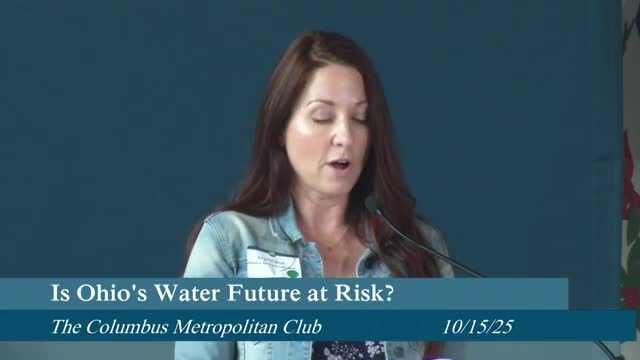H2Ohio program shows measurable water gains but faces deep budget cuts, panelists say
October 15, 2025 | Columbus City Council, Columbus, Franklin County, Ohio
This article was created by AI summarizing key points discussed. AI makes mistakes, so for full details and context, please refer to the video of the full meeting. Please report any errors so we can fix them. Report an error »

Speakers at a Columbus Metropolitan Club forum in Columbus said Ohio’s H2Ohio program has produced measurable improvements in farm- and watershed-level water quality since 2019, but that recent state budget reductions sharply cut the program’s funding.
"It currently it currently is being decimated by this budget," said Representative Dontavious Jarrells, Ohio House of Representatives, who described reductions of about $52–60 million annually to H2Ohio line items in the state budget signed July 1. Jarrells said roughly 73% of EPA-related H2Ohio funds, about 55% of Department of Natural Resources funds and about 12% of Department of Agriculture funds were removed in the latest budget.
H2Ohio was created as a three-part program funding agricultural practices, community water infrastructure and natural-resource projects, panelists said. Adam Sharp, executive vice president of the Ohio Farm Bureau Federation, recalled how farm groups, conservation organizations and state leaders developed the initiative to target nutrient pollution, infrastructure upgrades and natural solutions such as wetlands.
"That idea of three buckets was something that we forwarded and started talking with the legislature about," Sharp said, describing the coalition that supported H2Ohio’s creation.
Panelists credited the program with concrete outcomes on nutrient management and infrastructure upgrades, but said the funding cuts put future progress at risk. Representative Jarrells said the removed funds affect watershed protections, lead service line replacement programs, and other community-level investments that protect drinking water access.
Panelists urged continued advocacy and data-driven evaluation of program results. Bill Stanley, State Director of The Nature Conservancy in Ohio, said research on H2Ohio’s benefits was being finalized. "For every $1 of investment from H2Ohio that's gone into wetlands, $8 is returned in terms of benefit to people in Ohio," Stanley said, describing early results from a benefits study still being released.
The panelists asked citizens and local leaders to press lawmakers to restore or replace cuts, citing both public-health and economic returns from the program. Jarrells emphasized the human stakes: he framed clean water as a human-rights and public-health priority and called for bipartisan support to sustain investments.
Looking forward, panelists said tracking and publishing performance data is crucial to make the case for long-term funding and to adjust program components that do not perform as expected. Several speakers noted that H2Ohio was designed to evolve based on measured results and that ongoing evaluation would guide future spending.
A final Nature Conservancy research brief on program benefits was described as forthcoming.
"It currently it currently is being decimated by this budget," said Representative Dontavious Jarrells, Ohio House of Representatives, who described reductions of about $52–60 million annually to H2Ohio line items in the state budget signed July 1. Jarrells said roughly 73% of EPA-related H2Ohio funds, about 55% of Department of Natural Resources funds and about 12% of Department of Agriculture funds were removed in the latest budget.
H2Ohio was created as a three-part program funding agricultural practices, community water infrastructure and natural-resource projects, panelists said. Adam Sharp, executive vice president of the Ohio Farm Bureau Federation, recalled how farm groups, conservation organizations and state leaders developed the initiative to target nutrient pollution, infrastructure upgrades and natural solutions such as wetlands.
"That idea of three buckets was something that we forwarded and started talking with the legislature about," Sharp said, describing the coalition that supported H2Ohio’s creation.
Panelists credited the program with concrete outcomes on nutrient management and infrastructure upgrades, but said the funding cuts put future progress at risk. Representative Jarrells said the removed funds affect watershed protections, lead service line replacement programs, and other community-level investments that protect drinking water access.
Panelists urged continued advocacy and data-driven evaluation of program results. Bill Stanley, State Director of The Nature Conservancy in Ohio, said research on H2Ohio’s benefits was being finalized. "For every $1 of investment from H2Ohio that's gone into wetlands, $8 is returned in terms of benefit to people in Ohio," Stanley said, describing early results from a benefits study still being released.
The panelists asked citizens and local leaders to press lawmakers to restore or replace cuts, citing both public-health and economic returns from the program. Jarrells emphasized the human stakes: he framed clean water as a human-rights and public-health priority and called for bipartisan support to sustain investments.
Looking forward, panelists said tracking and publishing performance data is crucial to make the case for long-term funding and to adjust program components that do not perform as expected. Several speakers noted that H2Ohio was designed to evolve based on measured results and that ongoing evaluation would guide future spending.
A final Nature Conservancy research brief on program benefits was described as forthcoming.
View full meeting
This article is based on a recent meeting—watch the full video and explore the complete transcript for deeper insights into the discussion.
View full meeting
